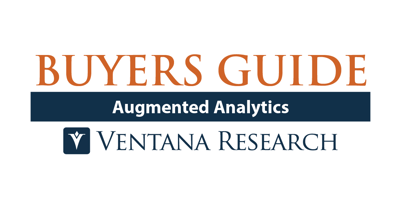The 2023 Ventana Research Buyers Guide for Augmented Analytics research enables me to provide observations about how the market has advanced.
For decades, organizations have been improving and expanding the way they use analytics and data software, commonly referred to as business intelligence (BI), to improve their  operations. Vendors have made dramatic improvements to BI products with highly interactive visualizations and the ability to process and display very large volumes of data quickly. However, organizations quest for more. Artificial intelligence and machine learning (AI/ML) has gained in popularity with 87% of participants in our Analytics and Data Benchmark Research indicating they have adopted or plan to adopt AI/ML.
operations. Vendors have made dramatic improvements to BI products with highly interactive visualizations and the ability to process and display very large volumes of data quickly. However, organizations quest for more. Artificial intelligence and machine learning (AI/ML) has gained in popularity with 87% of participants in our Analytics and Data Benchmark Research indicating they have adopted or plan to adopt AI/ML.
Adopting AI/ML has proven more complicated than many had expected. Ideally, BI software products could simply be extended to include a full set of AI/ML capabilities, but that has not yet happened. AI/ML requires skills that are beyond the reach of many analysts, and organizations have had difficulty finding skilled resources. As a result, we expect through 2025, AI and ML approaches will remain largely independent of BI approaches, requiring three-quarters of organizations to maintain multiple, separate skill sets.
yet happened. AI/ML requires skills that are beyond the reach of many analysts, and organizations have had difficulty finding skilled resources. As a result, we expect through 2025, AI and ML approaches will remain largely independent of BI approaches, requiring three-quarters of organizations to maintain multiple, separate skill sets.
Faced with this separation, BI software vendors have invested in ways to make AI/ML more accessible by augmenting the capabilities in their products. These combined capabilities have been referred to as augmented analytics or augmented intelligence. This report uses the term augmented analytics.
AI/ML can augment analytics in a variety of ways. Natural language processing (NLP) utilizes AI/ML to parse and understand language to support conversational analytics with natural language queries and narrative responses. Automated machine learning (AutoML) automates the process of creating ML models, making more sophisticated analytics such as customer segmentation using clustering techniques accessible to more individuals. And, AI/ML can be applied to many tasks in analytics and data processes to make those tasks easier to perform.
Perhaps the most common area to apply AI/ML assistance is in data preparation. Data preparation continues to be the area where organizations spend the most time in their analytics processes. AI/ML can be used to suggest which tables of data to combine and how to combine those tables. It can be used to automatically construct a logical data model from a physical data model. AI/ML can augment data quality processes, identifying outliers and anomalies in the data, even recommending potential corrections for those data points.
While efforts to apply AI/ML have been underway for some time, the sudden explosion of generative AI capabilities has fueled more interest in how to augment BI. Generative AI is being used to generate SQL to access data sources, and to enhance NLP and conversational analytics. In some cases, generative AI is being used to produce documentation of data pipelines used in analytics processes, enhancing the understanding and lineage of the data. In some ways, it is the wild, wild west, with vendors racing to outdo each other in the ways in which they can apply generative AI. The technology holds much promise, and we expect it will have a significant impact on the analytics market, but it is early days still.
Augmented analytics will continue to evolve. Generative AI is likely to make conversational analytics more common and more capable than it is today. It may enable better support for multilingual capabilities currently lacking in most analytics products and will likely lead to increased automation in data preparation processes and in creating initial analyses, making analysts much more productive. More products will offer AutoML capabilities. Among the vendors we evaluated, AutoML is most often used to generate forecasts and to perform customer segmentation analyses. Over time, AutoML capabilities will expand to support more types of analyses and will produce models with improved accuracy. The exact intersection between AutoML in augmented analytics products and the models produced from more sophisticated AI/ML products remains to be seen. Today some of the augmented analytics products can work with these models, but it still a loosely coupled process.
Organizations should be aware of the changes going on in the market, and should understand what capabilities their vendor currently offers. They should also be comparing their current offering with what other vendors have to offer. In evaluating augmented analytics, one must consider the underlying analytics capabilities. Great augmentation can only do so much if the foundation of underlying analytics is weak. Consequently, this Buyers Guide combines an assessment of augmented analytics capabilities with core analytics capabilities to determine the vendor’s overall rankings. Organizations can then use this report not only to help guide purchasing decisions, but to guide conversations with vendors about their roadmap for augmented analytics. The market is still evolving rapidly, but organizations can realize value today that will improve their analytics processes.
This research evaluates the following analytics and data vendors that offer products that include key elements of augmented analytics as we define it: AWS, Cloud Software Group, Domo, GoodData, Google, IBM, Idera, Incorta, Infor, insightsoftware, Microsoft, MicroStrategy, Oracle, Pyramid Analytics, Qlik, SAP, SAS, Sigma Computing, Sisense, Tableau Software, ThoughtSpot and Zoho.
You can find more details on our site as well as in the Buyers Guide Market Report.
Regards,
David Menninger


 operations. Vendors have made dramatic improvements to BI products with highly interactive visualizations and the ability to process and display very large volumes of data quickly. However, organizations quest for more. Artificial intelligence and machine learning (AI/ML) has gained in popularity with 87% of participants in our Analytics and Data Benchmark Research indicating they have adopted or plan to adopt AI/ML.
operations. Vendors have made dramatic improvements to BI products with highly interactive visualizations and the ability to process and display very large volumes of data quickly. However, organizations quest for more. Artificial intelligence and machine learning (AI/ML) has gained in popularity with 87% of participants in our Analytics and Data Benchmark Research indicating they have adopted or plan to adopt AI/ML.  yet happened. AI/ML requires skills that are beyond the reach of many analysts, and organizations have had difficulty finding skilled resources. As a result, we expect through 2025, AI and ML approaches will remain largely independent of BI approaches, requiring three-quarters of organizations to maintain multiple, separate skill sets.
yet happened. AI/ML requires skills that are beyond the reach of many analysts, and organizations have had difficulty finding skilled resources. As a result, we expect through 2025, AI and ML approaches will remain largely independent of BI approaches, requiring three-quarters of organizations to maintain multiple, separate skill sets. 








